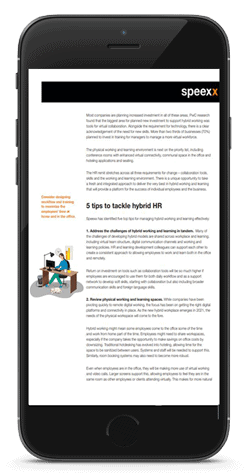Whitepaper
How to Manage the Hybrid Office
A Fresh Approach for the Emerging Hybrid World of Work
Now that companies and employees have experienced the benefits of flexible working, for many businesses there will be no going back to the old ways of doing things. While some employees may be back in the office, many more will still be working remotely for some time to come.

Whitepaper | How to Manage the Hybrid Office
Find out more about the hybrid office
In this whitepaper
How to invest in flexibility in the workplace
5 tips to tackle hybrid HR
Effective communication: The key to successful hybrid working

You might also be interested in
Webinar
F2F to Digital Learning – How to successfully adapt

What are the top challenges HR and L&D professionals face when switching from face-to-face (F2F) to digital learning and dealing with accelerated digital transformation? How can you overcome these challenges and what are the top things to keep in mind?
How to invest in flexibility for a hybrid office
Creating and managing the hybrid office is a more complex task than managing traditional fixed workplaces. It needs new and better collaboration technologies, in and out of the office. It demands different physical workspaces and new ways of sharing them. Hoteling has overtaken hotdesking, requiring employees to book shared spaces before using them, enabling the space to be made safe between users.
Most companies are planning increased investment in all of these areas. PwC research found that the biggest area for planned new investment to support hybrid working was tools for virtual collaboration. Alongside the requirement for technology, there is a clear acknowledgment of the need for new skills. More than two-thirds of businesses (70%) planned to invest in training for managers to manage a more virtual workforce.
Addressing the challenges of the hybrid office
Many of the challenges of developing hybrid models are shared across the workplace and learning, including virtual team structure, digital communication channels, and working and learning policies. HR and learning development colleagues can support each other to create a consistent approach to allowing employees to work and learn both in the office and remotely.
Return on investment on tools such as collaboration tools will be so much higher if employees are encouraged to use them for both daily workflows and as a support network to develop soft skills, starting with collaboration but also including broader communication skills and foreign language skills.
Effective communication: The key to successful hybrid working
As 82% of company leaders plan to allow employees to work remotely some of the time, almost a third of business leaders (30%) believe that maintaining corporate culture is one of the biggest challenges of managing a hybrid workforce. For many companies, the transition towards a hybrid model of working and learning will drive a culture change towards more self-direction, more collaboration, and less micromanagement.
In this emerging hybrid world of work, communicating and collaborating effectively is key to making it all work. Employees and managers will need high-level soft skills.
